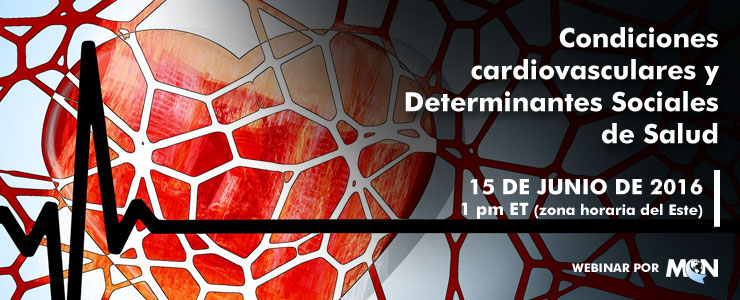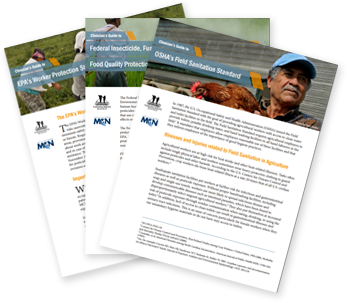
MCN and Farmworker Justice offer these guides to assist clinicians in understanding farmworker health and safety regulations. OSHA’s Field Sanitation Standard; EPA's Federal Insecticide, Fungicide, and Rodenticide Act (FIFRA); EPA's Food Quality Protection Act (FQPA); EPA’s Worker Protection Standard (WPS).
- OSHA's Field Sanitation Standard Clinician's Guide.pdf (747.53 KB)
- FIFRA FQPA Clinician's Guide.pdf (287.9 KB)
- WPS Clinician's Guide.pdf (843.35 KB)
The 1999–2013 United States Cancer Statistics (USCS): Incidence and Mortality Web-based Report includes the official federal statistics on cancer incidence from registries that have high-quality data, and cancer mortality statistics. It is produced by the Centers for Disease Control and Prevention (CDC) and the National Cancer Institute (NCI). This report shows that in 2013, 1,536,119 Americans received a new diagnosis of invasive cancer, and 584,872 Americans died of this disease (these counts do not include in situ cancers or the more than 1 million cases of basal and squamous cell skin cancers diagnosed each year).
This year’s report features information on invasive cancer cases diagnosed during 2013, the most recent year of incidence data available, among residents of 49 states, six metropolitan areas, and the District of Columbia—geographic areas in which about 99% of the U.S. population resides. Incidence data are from CDC’s National Program of Cancer Registries (NPCR) and NCI’s Surveillance, Epidemiology, and End Results (SEER) Program. Data from population-based central cancer registries in these states and metropolitan areas meet the criteria for inclusion in this report.
The report also provides cancer mortality data collected and processed by CDC’s National Center for Health Statistics. Mortality statistics, based on records of deaths that occurred during 2013, are available for all 50 states and the District of Columbia.
The report also includes incidence rates and counts for Puerto Rico for 2009 through 2013 by sex and age, as well brain tumor and childhood cancer data.
USCS data are presented in the following applications—
- https://nccd.cdc.gov/uscs/?s_cid=govD_USCS2013_1
- http://links.govdelivery.com/track?type=click&enid=ZWFzPTEmbWFpbGluZ2lkPTIwMTYwNzA2LjYxMjE2OTcxJm1lc3NhZ2VpZD1NREItUFJELUJVTC0yMDE2MDcwNi42MTIxNjk3MSZkYXRhYmFzZWlkPTEwMDEmc2VyaWFsPTE3MDg5NzQwJmVtYWlsaWQ9dGx5b25zQG1pZ3JhbnRjbGluaWNpYW4ub3JnJnVzZXJpZD10bHlvbnNAbWlncmFudGNsaW5pY2lhbi5vcmcmZmw9JmV4dHJhPU11bHRpdmFyaWF0ZUlkPSYmJg%3D%3D&101=&https%3A%2F%2Fnccd_cdc_gov%2Fuscs%2F%3Fs_cid=govD_USCS2013_2
- http://links.govdelivery.com/track?type=click&enid=ZWFzPTEmbWFpbGluZ2lkPTIwMTYwNzA2LjYxMjE2OTcxJm1lc3NhZ2VpZD1NREItUFJELUJVTC0yMDE2MDcwNi42MTIxNjk3MSZkYXRhYmFzZWlkPTEwMDEmc2VyaWFsPTE3MDg5NzQwJmVtYWlsaWQ9dGx5b25zQG1pZ3JhbnRjbGluaWNpYW4ub3JnJnVzZXJpZD10bHlvbnNAbWlncmFudGNsaW5pY2lhbi5vcmcmZmw9JmV4dHJhPU11bHRpdmFyaWF0ZUlkPSYmJg%3D%3D&102=&https%3A%2F%2Fnccd_cdc_gov%2FDCPC_INCA%2F%3Fs_cid=govD_USCS2013_3
- http://links.govdelivery.com/track?type=click&enid=ZWFzPTEmbWFpbGluZ2lkPTIwMTYwNzA2LjYxMjE2OTcxJm1lc3NhZ2VpZD1NREItUFJELUJVTC0yMDE2MDcwNi42MTIxNjk3MSZkYXRhYmFzZWlkPTEwMDEmc2VyaWFsPTE3MDg5NzQwJmVtYWlsaWQ9dGx5b25zQG1pZ3JhbnRjbGluaWNpYW4ub3JnJnVzZXJpZD10bHlvbnNAbWlncmFudGNsaW5pY2lhbi5vcmcmZmw9JmV4dHJhPU11bHRpdmFyaWF0ZUlkPSYmJg%3D%3D&103=&https%3A%2F%2Fnccd_cdc_gov%2FStateCancerFacts%2F%3Fs_cid=govD_USCS2013_4
From the 2016 International Union Against Tuberculosis & Lung Disease Conference
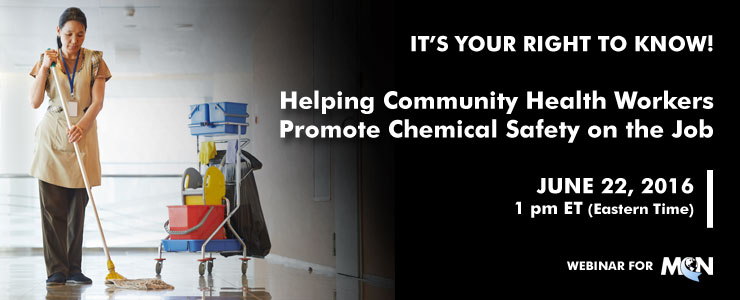
DATE RECORDED: June 22, 2016
PRESENTED BY: Kerry Brennan
This material will be produced under grant number SH-27640-15-60-F-48-SH5 from the Occupational Safety and Health Administration, U.S. Department of Labor. It will not necessarily reflect the views or policies of the U.S. Department of Labor, nor does mention of trade names, commercial products, or organizations imply endorsement by the U.S. Government.

FECHA DE GRABACION: 29 de Junio de 2016
Oradora: Victoria Adela Breckwich Vásquez, DrPH, MPH, MA and Ricardo Garay
- http://migrantclinician.adobeconnect.com/p3ecsy3l2x8/?OWASP_CSRFTOKEN=c25525b1aaee94cd85cf1ee30a1de44f393a11c31d8160d7f04cc9838a5c15bf
- http://www.migrantclinician.org/
- http://depts.washington.edu/pnash/sexual_harassment
- http://www.migrantclinician.org/services/initiatives/family-violence-prevention/hucvf.html
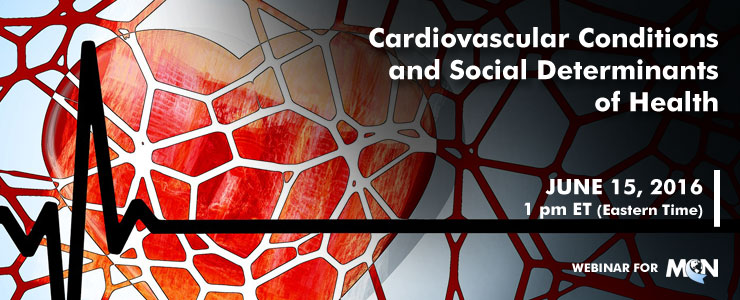
DATE RECORDED: June 15, 2016
PRESENTED BY: Dra. Maura Patricia García Castillo, MD, MPH
- http://www.migrantclinician.org/
- http://www.chegg.com/etextbooks/an-introduction-to-community-public-health-8th-edition-9781449689896-1449689892
- http://ccsdh.ca/publications/results/051a9d49e8044812976859b07cc2507a/
- http://www.phac-aspc.gc.ca/publicat/hpcdp-pspmc/36-2/index-eng.php
- http://www.ncbi.nlm.nih.gov/pubmed/27018728
- http://openheart.bmj.com/content/3/1/e000356.full
- http://nam.edu/wp-content/uploads/2016/05/Numbers-Get-In-the-Way.pdf
- http://www.nap.edu/catalog/21863/food-literacy-how-do-communications-and-marketing-impact-consumer-knowledge
- http://circ.ahajournals.org/content/133/13/1302
- http://www.nap.edu/author/FNB/health-and-medicine-division/food-and-nutrition-board
- https://www.epa.gov/sites/production/files/2016-02/documents/childrens_health_environmental_impacts_and_social_determinants.pdf
FECHA DE GRABACION: 15 de Junio de 2016
Oradora: Dra. Maura Patricia García Castillo, MD, MPH
- http://www.migrantclinician.org/
- http://www.chegg.com/etextbooks/an-introduction-to-community-public-health-8th-edition-9781449689896-1449689892
- http://ccsdh.ca/publications/results/051a9d49e8044812976859b07cc2507a/
- http://www.phac-aspc.gc.ca/publicat/hpcdp-pspmc/36-2/index-eng.php
- http://www.ncbi.nlm.nih.gov/pubmed/27018728
- http://openheart.bmj.com/content/3/1/e000356.full
- http://nam.edu/wp-content/uploads/2016/05/Numbers-Get-In-the-Way.pdf
- http://www.nap.edu/catalog/21863/food-literacy-how-do-communications-and-marketing-impact-consumer-knowledge
- http://circ.ahajournals.org/content/133/13/1302
- http://www.nap.edu/author/FNB/health-and-medicine-division/food-and-nutrition-board
- https://www.epa.gov/sites/production/files/2016-02/documents/childrens_health_environmental_impacts_and_social_determinants.pdf
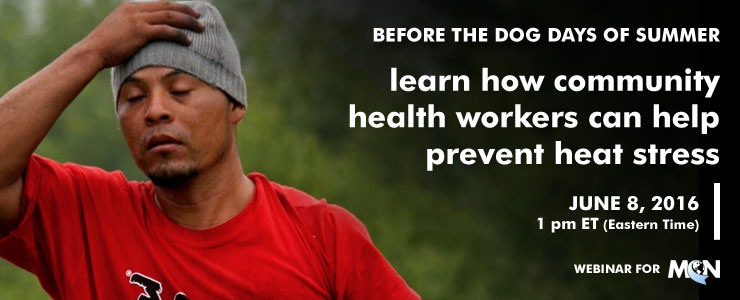
DATE RECORDED: June 8, 2016
PRESENTED BY: Juliana Simmons, MSPH, CHES
This material will be produced under grant number SH-27640-15-60-F-48-SH5 from the Occupational Safety and Health Administration, U.S. Department of Labor. It will not necessarily reflect the views or policies of the U.S. Department of Labor, nor does mention of trade names, commercial products, or organizations imply endorsement by the U.S. Government.
- https://youtu.be/qcCci3GQs04
- http://www.migrantclinician.org/
- https://www.osha.gov/SLTC/heatstress/prevention.html
- http://www.farmworkerjustice.org/sites/default/files/FJpesticidetrainingspanish2016.pdf
- https://www.osha.gov/SLTC/heatstress/index.html
- https://www.osha.gov/SLTC/heatillness/index.html
- https://www.osha.gov/SLTC/heatstress/industry_resources.html
- http://www.dir.ca.gov/dosh/heatIllnessQA.html
- http://www.lni.wa.gov/Safety/Topics/AtoZ/HeatStress/
- http://en.hesperian.org/hhg/Workers%27_Guide_to_Health_and_Safety:Dangers_from_heat
- http://www.naplesnews.com/news/crime/report-farmworkers-death-should-have-been-prevented-2738c212-4e00-109c-e053-0100007fd972-363310521.html
- http://www.cdc.gov/niosh/topics/heatstress/heatrelillness.html
DATE RECORDED: May 25, 2016
PRESENTED BY: Antonio Tovar, PhD
This material will be produced under grant number SH-27640-15-60-F-48-SH5 from the Occupational Safety and Health Administration, U.S. Department of Labor. It will not necessarily reflect the views or policies of the U.S. Department of Labor, nor does mention of trade names, commercial products, or organizations imply endorsement by the U.S. Government.
- http://migrantclinician.adobeconnect.com/p7ivm2ufeen/?OWASP_CSRFTOKEN=ac591cd08f9863f71c6bcfb170562ec542246ffe6bcc46dd96e925e4d31b1e6d
- http://www.migrantclinician.org/
- https://www.osha.gov/SLTC/heatstress/prevention.html
- http://www.farmworkerjustice.org/sites/default/files/FJpesticidetrainingspanish2016.pdf
FECHA DE GRABACION: 25 de Mayo de 2016
PRESENTAOD POR: Antonio Tovar, PhD
Este material será producido bajo la subvención número SH-27640-15-60-F-48-SH5 de la Administración de Seguridad y Salud Ocupacional del Departamento de Trabajo de los Estados Unidos. Ni los puntos de vista ni las políticas del Departamento de Trabajo de los Estados Unidos serán necesariamente reflejados; ni la mención de nombres comerciales, productos comerciales, u organizaciones implica la aprobación por el Gobierno de EE.UU.
- http://migrantclinician.adobeconnect.com/p7ivm2ufeen/?OWASP_CSRFTOKEN=ac591cd08f9863f71c6bcfb170562ec542246ffe6bcc46dd96e925e4d31b1e6d
- http://www.migrantclinician.org/
- https://www.osha.gov/SLTC/heatstress/prevention.html
- http://www.farmworkerjustice.org/sites/default/files/FJpesticidetrainingspanish2016.pdf
As part of the response to the Zika outbreak, CDC, in collaboration with state, local, tribal, and territorial health departments, established a pregnancy registry for comprehensive monitoring of pregnancy and infant outcomes following possible Zika virus infection. The registry is an active surveillance system of pregnant women with laboratory evidence of possible Zika virus infection in the 50 US states and DC, and in the US territories. On May 20, 2016, CDC released detailed information about the registry and will initiate weekly reporting of the number of pregnant women followed in the registry.
The U.S. Environmental Protection Agency’s (EPA) Worker Protection Standard (WPS) provides basic workplace protections to farmworkers and pesticide handlers to minimize the adverse effects of pesticide exposure. EPA announced major revisions to the WPS in September 2015. MCN and FJ's fact sheet provides a summary of the revised regulation.
- WPS-2015.pdf (981.69 KB)
Aedes species mosquitoes transmit chikungunya virus, as well as dengue and Zika viruses, and bite most often during the day.* Infectious mosquito bites frequently occur in and around homes (1,2). Caribbean countries first reported local transmission of chikungunya virus in December 2013, and soon after, chikungunya virus spread throughout the Americas (3). Puerto Rico reported its first laboratory-positive chikungunya case in May 2014 (4), and subsequently identified approximately 29,000 suspected cases throughout the island by the end of 2015 ...
In May 2015, Zika virus was reported to be circulating in Brazil. This was the first identified introduction of the virus in the Region of the Americas. Since that time, Zika virus has rapidly spread throughout the region. As of April 20, 2016, the Florida Department of Health Bureau of Public Health Laboratories (BPHL) has tested specimens from 913 persons who met state criteria for Zika virus testing. Among these 913 persons, 91 met confirmed or probable Zika virus disease case criteria and all cases were travel-associated (1).
Diagnostic testing for Zika virus infection can be accomplished using molecular and serologic methods. Real-time reverse transcription–polymerase chain reaction (rRT-PCR) is the preferred test for Zika virus infection because it can be performed rapidly and is highly specific (1,2) ...
- resourceZika-05112016.pdf (95.67 KB)
In 2015, for the first time in over 20 years, the Environmental Protection Agency updated the Worker Protection Standard (WPS). The WPS provides basic workplace protections for agricultural workers to reduce the risk of pesticide exposre. This issue brief overviews the major revisions that are particularly relevant for clinicians caring for agricultural workers.
- WPS_MCN_FJ_IssuesBrief2016.pdf (3.02 MB)

ACA Toolkit:
Available in English and Spanish
Health Insurance Guide:
Available in English and Spanish and Haitian Creole
Older Guides:
Available in English, Spanish, and Haitian Creole for workers on employer-provided health insurance
Created by Farmworker Justice.
- http://www.farmworkerjustice.org/sites/default/files/FJ_ACA_Fact_Sheet_Employer_Provided_Health_Insurance_FINAL.pdf
- http://www.farmworkerjustice.org/sites/default/files/FJ_ACA_Fact_Sheet_Employer_Provided_Health_Insurance_SPANISH_FINAL.pdf
- http://www.farmworkerjustice.org/sites/default/files/FJ_ACA_Fact_Sheet_Employer_Provided_Health_Insurance_CREOLE_FINAL.pdf
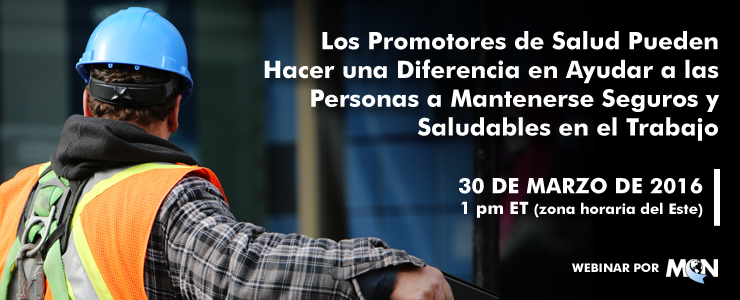
DATE RECORDED: March 30, 2016
PRESENTED BY: Ileana Ponce-González, MD, MPH
This material will be produced under grant number SH-27640-15-60-F-48-SH5 from the Occupational Safety and Health Administration, U.S. Department of Labor. It will not necessarily reflect the views or policies of the U.S. Department of Labor, nor does mention of trade names, commercial products, or organizations imply endorsement by the U.S. Government.
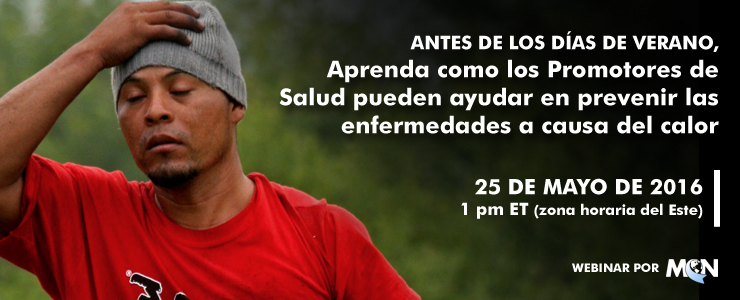
FECHA DE GRABACION: 25 de Mayo de 2016
PRESENTAOD POR: Antonio Tovar, PhD
- Ver Webinar Grabado
- Evaluacion de los Participantes
- Diapositivas de la Presentacion
Este material será producido bajo la subvención número SH-27640-SH5 de la Administración de Seguridad y Salud Ocupacional del Departamento de Trabajo de los Estados Unidos. Ni los puntos de vista ni las políticas del Departamento de Trabajo de los Estados Unidos serán necesariamente reflejados; ni la mención de nombres comerciales, productos comerciales, u organizaciones implica la aprobación por el Gobierno de EE.UU.
- http://www.migrantclinician.org/
- https://www.osha.gov/SLTC/heatstress/index.html
- https://www.osha.gov/SLTC/heatillness/spanish/index_sp.html
- https://www.osha.gov/SLTC/heatstress/industry_resources.html
- http://deohs.washington.edu/pnash/heat_illness
- http://www.dir.ca.gov/dosh/heatIllnessQA.html
- http://www.lni.wa.gov/Safety/Topics/AtoZ/HeatStress/
- http://en.hesperian.org/hhg/Workers%27_Guide_to_Health_and_Safety:Dangers_from_heat
- http://www.naplesnews.com/news/crime/report-farmworkers-death-should-have-been-prevented-2738c212-4e00-109c-e053-0100007fd972-363310521.html
The National LGBT Health Education Center provides educational programs, resources, and consultation to health care organizations with the goal of optimizing quality, cost-effective health care for lesbian, gay, bisexual, and transgender (LGBT) people.
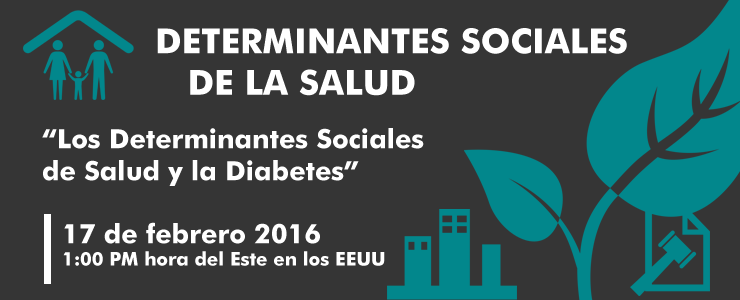
FECHA DE GRABACION: 17 de febrero 2016
PRESENTADO POR: Ileana Ponce-González, MD, MPH | Nelly Ayala, RN, MSN | Juan J Martinez, MSN, RN, CDE
- http://migrantclinician.adobeconnect.com/p4r9q058gd5/?OWASP_CSRFTOKEN=5cda39ea343db034320a5f908410459c08acbc6dc8eae39211163603ad29bfe2
- http://www.migrantclinician.org/
- http://www.ncbi.nlm.nih.gov/pubmed/11024588
- http://scholarworks.boisestate.edu/nursing_facpubs/3/
- http://www.ncbi.nlm.nih.gov/pmc/articles/PMC3662286/
- http://www.idf.org/diabetesvoice/articles/diabetes-tipo-2-su-prevenci%C3%B3n-y-la-comisi%C3%B3n-sobre-determinantes-sociales-de-la-salud-de-la
- http://www.doh.wa.gov/Portals/1/Documents/Pubs/345-342-DiabetesEpidemicActionReport.pdf
- http://ibis.dhss.alaska.gov/
- http://www.paho.org/diabetes
- http://www.diabetes.org/
- http://scielo.sld.cu/scielo.php?script=sci_arttext&pid=S1561-29532003000200008&lng=es&nrm=iso&tlng=es
- https://www.youtube.com/watch?v=_11xLlwKgWc
- http://www.hopeheart.org/our-programs/

FECHA DE GRABACION: 30 de Marzo de 2016
PRESENTAOD POR: Ileana Ponce-González, MD, MPH
Este material será producido bajo la subvención número SH-27640-15-60-F-48-SH5 de la Administración de Seguridad y Salud Ocupacional del Departamento de Trabajo de los Estados Unidos. Ni los puntos de vista ni las políticas del Departamento de Trabajo de los Estados Unidos serán necesariamente reflejados; ni la mención de nombres comerciales, productos comerciales, u organizaciones implica la aprobación por el Gobierno de EE.UU.
- http://migrantclinician.adobeconnect.com/p92vsy5l9ox/
- http://www.migrantclinician.org/
- http://workerscomphub.org/
- http://workerscomphub.org/navigating-system
- http://www.migrantclinician
- https://www.osha.gov/workers-spanish/index.html
- http://www.coshnetwork.org/know-your-rights
- http://hesperian.org/books-and-resources/

DATE RECORDED: March 30, 2016
PRESENTED BY: Ileana Ponce-González, MD, MPH
This material will be produced under grant number SH-27640-15-60-F-48-SH5 from the Occupational Safety and Health Administration, U.S. Department of Labor. It will not necessarily reflect the views or policies of the U.S. Department of Labor, nor does mention of trade names, commercial products, or organizations imply endorsement by the U.S. Government.
A primary goal of the Partnerships for Care (P4C) project is to provide innovative, cost-efficient, and culturally competent training and technical assistance (TTA) to the four health departments and 22 health centers serving high HIV prevalence areas funded under the project. To that end, the HIV Training, Technical Assistance, and Collaboration Center (HIV TAC) was funded to support the goals of the P4C project through planned collaboration with existing HIV-related TTA programs, across different levels of government and with nongovernment partners. The MayaTech Corporation operates the P4C HIV TAC.
This is a resource dedicated to researching educational opportunities within public health to help make the decision to get your degree, go back to get your degree, or further your education with a master's or doctoral degree in public health. With over 150 schools and over 2,000 public health degrees in this database, this is a comprehensive resource for you to utilize when figuring out which public health program is best for you.
Video interview with COPE Executive Director Mark Sullivan, MD, PhD.
About COPE: The University of Washington’s COPE for Chronic Pain CME Program offers evidence-based clinical knowledge and training on how best to treat patients experiencing chronic pain. COPE CME helps clinicians assess patients and monitor their progress, mitigate risk, and focus on restoring function and quality of life. It provides guidance on when and how to start, stop, or modify opioid therapies. COPE’s online course includes case-based video vignettes that model interactions between providers and patients, helping to improve communications that promote trust. Live and web-based CME is available.
Only 25% of physicians feel very confident in managing patients on opioids.
When many of today's physicians were in medical school, they learned that opioids were safe, and no dose seemed too high. Now, evidence-based practice paints a far more nuanced picture. More than 200 million prescriptions a year have contributed to widespread problems:
- 33% of young adults say that prescription opioids are "easy to get," with many taking their friends' or parents' pills.
- Nearly 20% of U.S. veterans with PTSD are receiving higher-dose or multiple opioids, or early refills.
- Increased prescribing to women of childbearing age has contributed to a 4-fold increase in neonatal abstinence syndrome
COPE offers free CME on safe opioid prescribing:
- COPE-REMS: an online, self-paced tutorial that awards up to 4 CME credits
- UW TelePain: Providers can call in to UW Medicine and present their most difficult chronic pain cases to a multidisciplinary panel of pain medicine experts for discussion and advice. Tune in to live, lunchtime, 1-hour sessions most Wednesdays at 12 PM to earn up to 1.5 CME credits per session.
Other resources from COPE include:
- 7 Things You Should Know about PTSD and Use of Opioid Pain Medications
- Women, Pregnancy & Prescription Opioids
- COPE-REMS has posted new content on prescribing opioids for chronic pain related to the 2015 Washington State Interagency Guideline on Prescribing Opioids for Pain. The 2015 guideline provides valuable insights for clinicians nationwide and for the federal government, which is now developing a national guideline. COPE interviewed Dr. David Tauben, Chief of the University of Washington Division of Pain Medicine.
- http://www.coperems.org/
- http://www.coperems.org/register/
- http://depts.washington.edu/anesth/care/pain/telepain/index.shtml
- http://www.coperems.org/wp-content/uploads/2015/06/flyer-ptsd-opioids-rev.pdf
- http://www.coperems.org/wp-content/uploads/2015/05/factsheet-womenpregnancy.pdf
- http://www.coperems.org/new-washington-state-opioid-guidelines/
